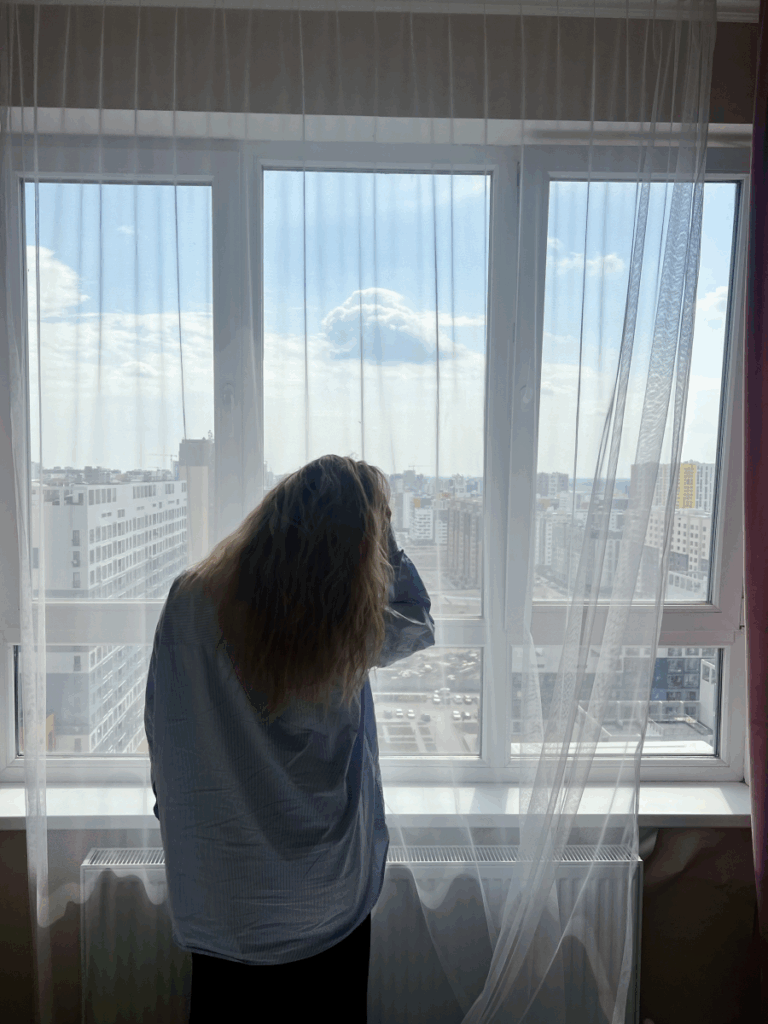Astana isn’t the kind of place people dream about visiting. It’s not charming. It’s not cozy. It’s not even particularly welcoming. And yet—there’s something about it that makes you glad you came.
Kazakhstan’s capital is a surreal blend of futuristic architecture, eerily empty streets, and moments that leave you wondering if you’ve stumbled into some kind of alternate reality. From palatial mosques to glass pyramids and tent-shaped malls, Astana is bold, bizarre, and—at times—downright bewildering.
At one point, I was stopped by guards when I tried to get closer to the Presidential Palace. I passed wide streets that felt oddly empty for a capital city, then drifted into rooftop bars and wandered through city gardens being meticulously tended by workers. It’s the kind of place that makes you curious—the more you see, the more you want to understand. This honest Astana travel guide will help you decide if Kazakhstan’s capital deserves a spot on your itinerary—and if so, how to make the most of your visit with practical tips, must-see sights, and an unfiltered take on what to really expect.
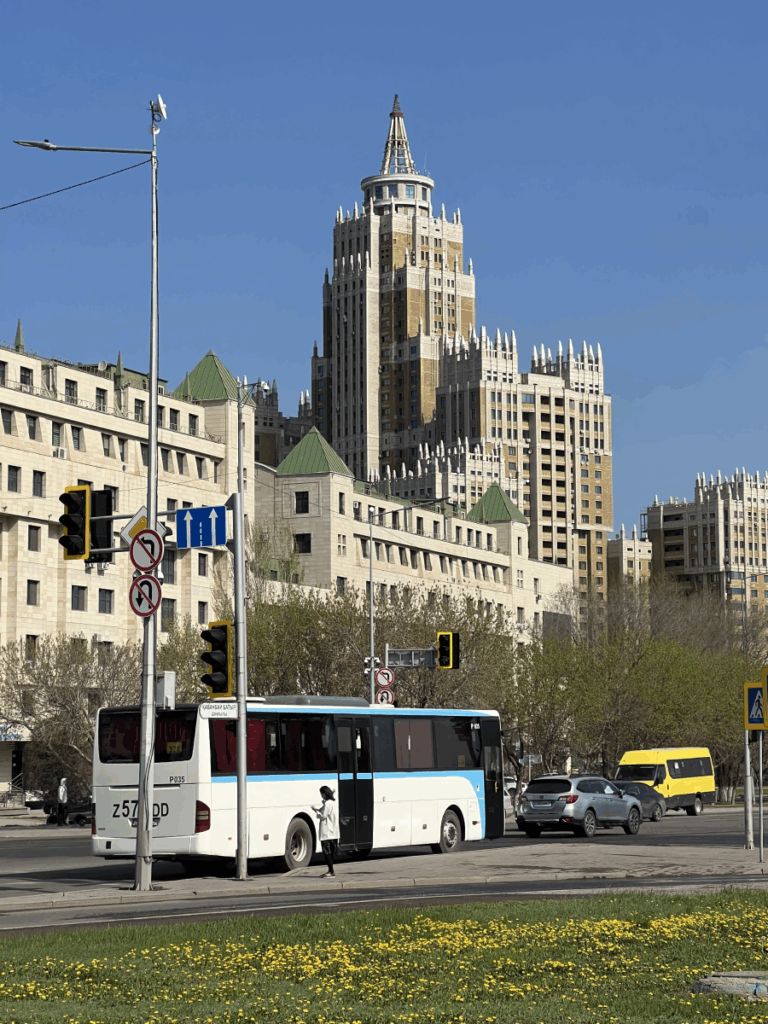
Astana at a glance: What to know before you go
Where:
Astana—whose name simply means “capital city” in Kazakh—has worn several names over the years. It officially became Astana in 1998, was briefly renamed Nur-Sultan in 2019 to honor the former president, and reverted back to Astana in 2022.Today, this bold, futuristic city rises out of Kazakhstan’s northern steppe. Most visitors arrive via Nursultan Nazarbayev International Airport and take a Yandex taxi (no Bolt or Uber here) for the 30-minute ride into the center.
When:
The best time to visit Astana is in late spring (May–June) or early autumn (September), when temperatures are mild and the skies are clear.
Astana holds the title of coldest capital city in the world, with winters that regularly plunge to -30°C (-22°F). Summers can swing surprisingly hot, so the shoulder seasons offer the most comfortable weather for exploring.
How long:
Most travelers find that 2–4 days in Astana is the right balance—enough to see the highlights and still have time to settle into the city’s peculiar rhythm.
Vibe:
Think Dubai meets Soviet minimalism on an empty stage—futuristic, surreal, eerily quiet, and just weird enough to make you wonder if you dreamed the whole thing.
The good, the weird, and the bad: What it’s really like to visit Astana
The good:
Astana’s biggest draw is how unexpectedly futuristic it feels. The cityscape is a surreal mix of futuristic skyscrapers, monumental avenues, and gleaming towers that look like something out of a retro sci-fi film. I felt completely safe the entire time—locals were polite but mostly kept to themselves.
Better yet, Astana is incredibly affordable compared to most global capitals. You can dine well, explore the city, and even treat yourself to rooftop cocktails without draining your wallet.
The weird:
Honestly? Astana is one of the strangest cities I’ve ever visited.
At one point, we tried to walk closer to the Presidential Palace, only to be stopped by guards who seemed to appear out of nowhere. The wide streets often felt oddly empty—like the set of a futuristic film where the actors never showed up.
Some massive, show-stopping buildings don’t even appear on Google Maps, while perfectly tended flower beds and decorative gardens line the streets with almost surreal precision—adding to the sense of disconnection. There’s an unsettling stillness to the city that makes you wonder: who was this place really built for?
The bad:
If you’re expecting lively streets and bustling cafés, you might find Astana quieter than you imagined. It didn’t have the vibrant energy of cities like Tbilisi or Istanbul—at least, not in the areas I explored. The distances between sights are vast, and unless you’re hopping between Yandex taxis, it’s not particularly walkable.
The weather, too, can be unforgiving—Astana is the coldest capital city in the world, with winters that regularly drop to -30°C (-22°F). Even in summer, the wind gives the city an edge of harshness.
And while Astana is visually fascinating, some travelers might find it a little sterile—more showpiece than lived-in heart. At times, it can feel like a city designed for the spotlight rather than for the people who actually live there.
Top things to do in Astana
From futuristic skyscrapers to serene mosques and overpriced rooftop cocktails, Astana isn’t short on things to see—it’s just… different. Here’s what I actually did in Astana (plus a few popular spots I didn’t have time for), with my honest take on what’s worth your time.
1. Visit the Grand Mosque of Astana
Easily the most breathtaking building we saw. The Grand Mosque of Astana is immense—so vast it felt more like a palace than a place of worship. Inside, the beige-and-gold interiors are serene, with soft lighting and impossibly high ceilings. I haven’t seen many mosques in my travels, but this one genuinely stood out.
They provide blue robes at the entrance so you can cover up appropriately (and honestly—it made for some beautiful photos too).
Quick tip: Even if you’re not usually drawn to religious sites, this one is worth seeing.
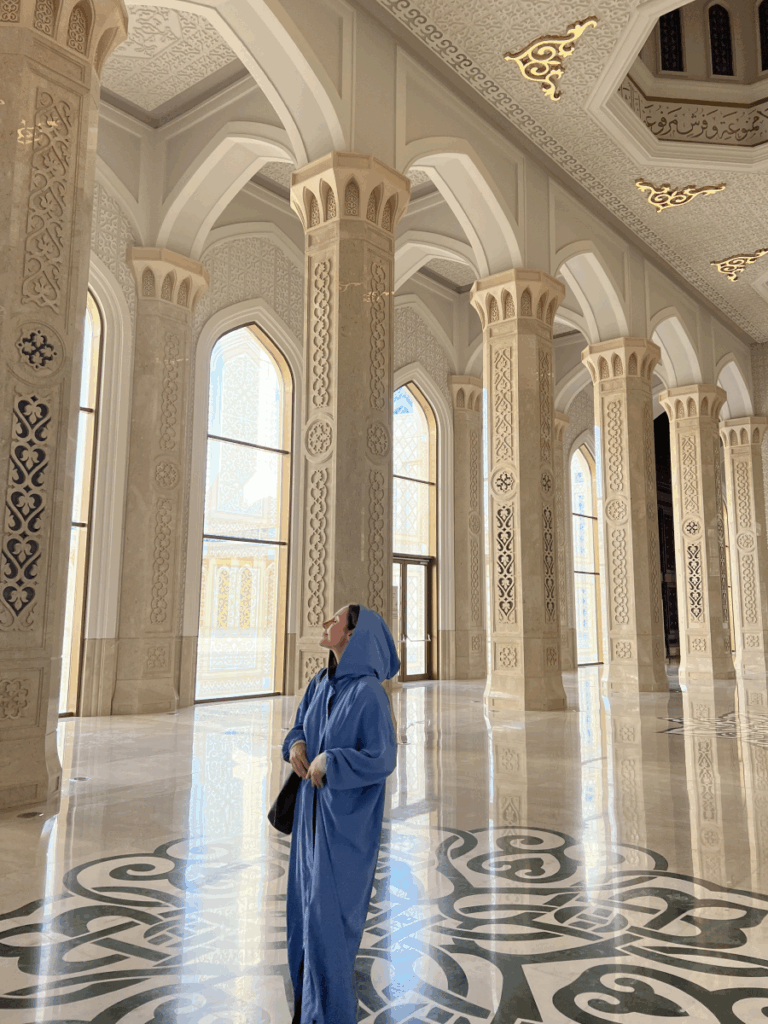
2. Snap a photo of Bayterek Tower (no need to go inside)
The Bayterek Tower is Astana’s postcard image—a golden orb balanced on a futuristic stem. I didn’t make it inside this time, but honestly, the tower looks best from afar anyway, especially when you spot it framed by the arch of the surrounding skyscrapers.
Quick tip: Head to Lover’s Park for a great view of Bayterek in a relaxed setting.
3. Wander through Lover’s Park
One of the nicer green spaces in Astana, Lover’s Park is a small but pleasant spot for a stroll or a sit-down. A few locals were hanging out when we visited—definitely not crowded, but it felt more alive than many other parts of the city. The gardens, sculptures, and fountains give it charm, and the view of Bayterek framed by the archway is a great photo moment.
Quick tip: Any time of day works here, but we found it especially peaceful in daylight.
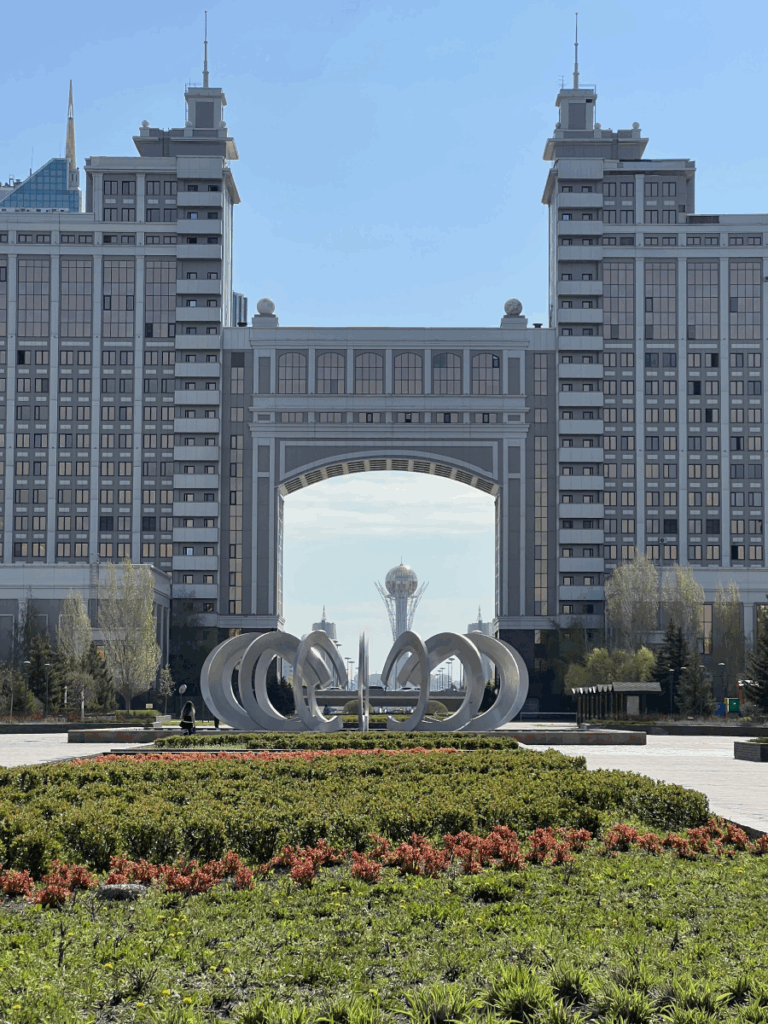
4. Eat local food with a view at Selfie
We had lunch at Selfie Restaurant Astana, a sleek panoramic spot with city views and a menu that mixes modern Kazakh dishes with international favorites. I couldn’t help but stick with my laghman obsession—I ordered it here too and genuinely enjoyed it.
The space is stylish but relaxed, and at least for lunch, we didn’t need a reservation—just walked in and grabbed a table.
Quick tip: If you’re after city views, ask for a window table. It’s a little pricier than average for Astana, but still very affordable by Western standards.
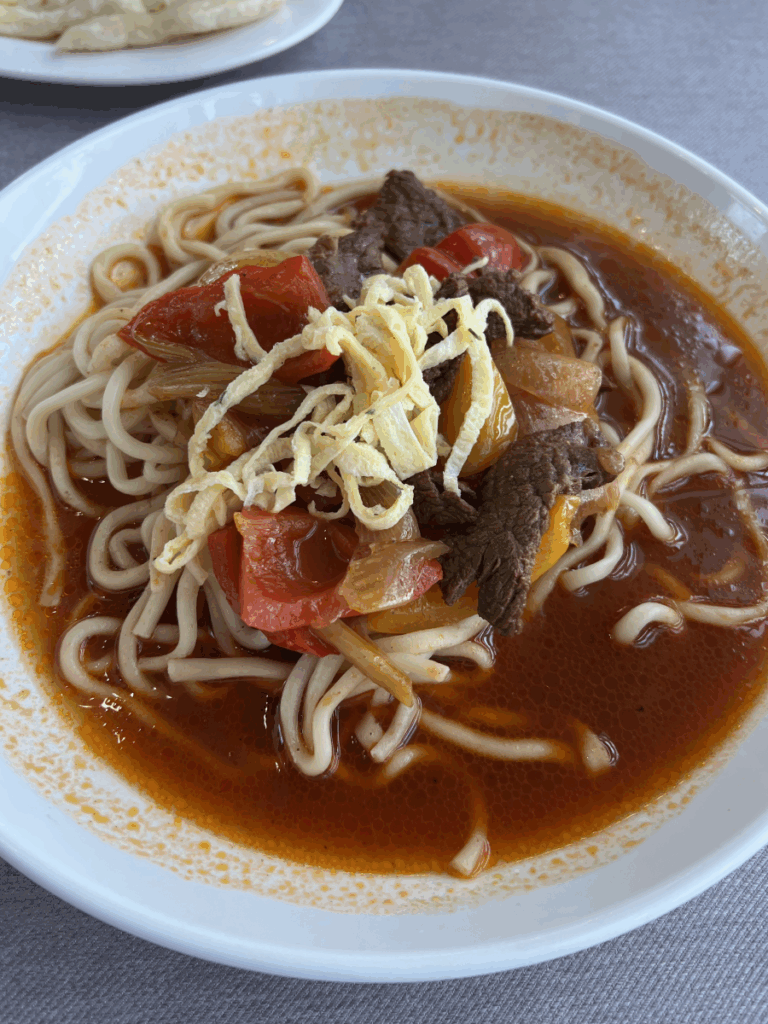
5. Visit Nur Astana Mosque (quick stop)
A smaller mosque compared to the Grand Mosque, the Nur Astana Mosque isn’t essential but makes for a nice quick stop if you’re nearby. We passed by on our way to the city center, popped in, and were back out in 15 minutes.
Quick tip: Worth it if you’re in the area, but not a must-see.
6. Check out the Presidential Palace (from afar) & First President’s Park
We tried to get closer to the Presidential Palace—but were stopped by guards who quietly appeared from behind trees and corners. Instead, we wandered First President’s Park, a low-key green space where a few people were out walking dogs or sitting on benches. The one standout? You still get a pretty close view of the palace.
Quick tip: You won’t get anywhere near the actual palace, but the park makes a peaceful spot to sit for a bit.
7. Cocktails at On The Roof
One of my favorite spots in Astana was On The Roof, a surprisingly chic rooftop bar with comfortable seating, city views, and (wildly overpriced) cocktails. The vibe was relaxed and stylish, and it felt like the kind of place you could linger for a while and actually unwind.
Quick tip: Head up for the views—sunset is a bonus if you time it right. We walked in without a reservation, but you might want to check ahead if you’re going on a weekend.
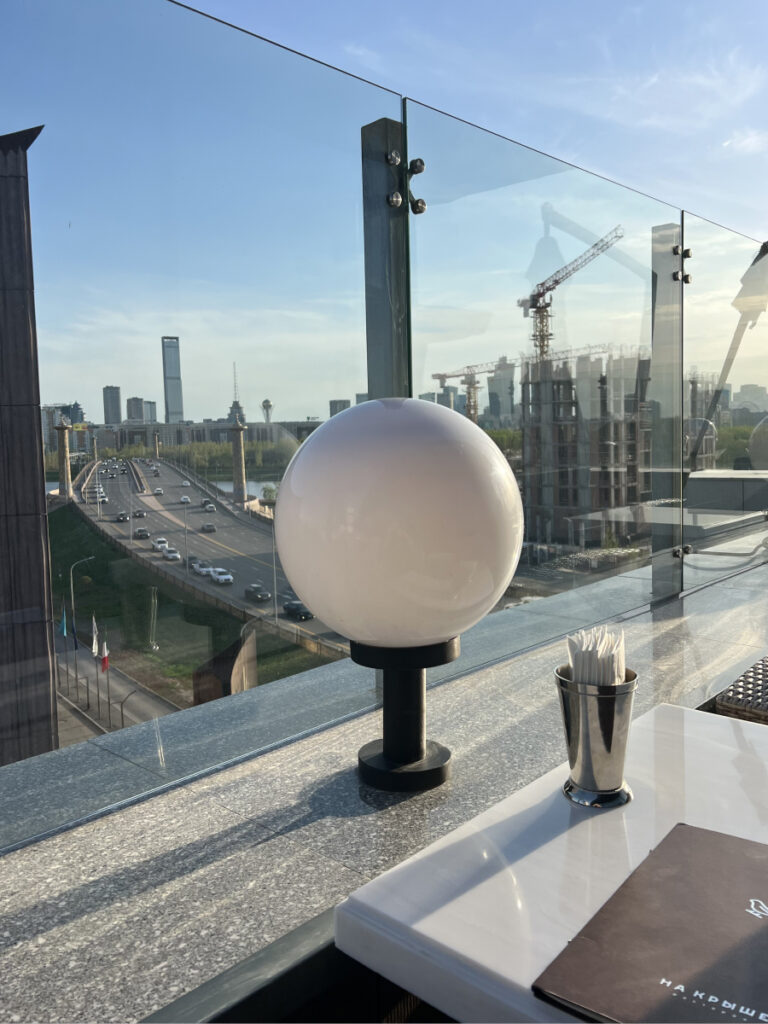
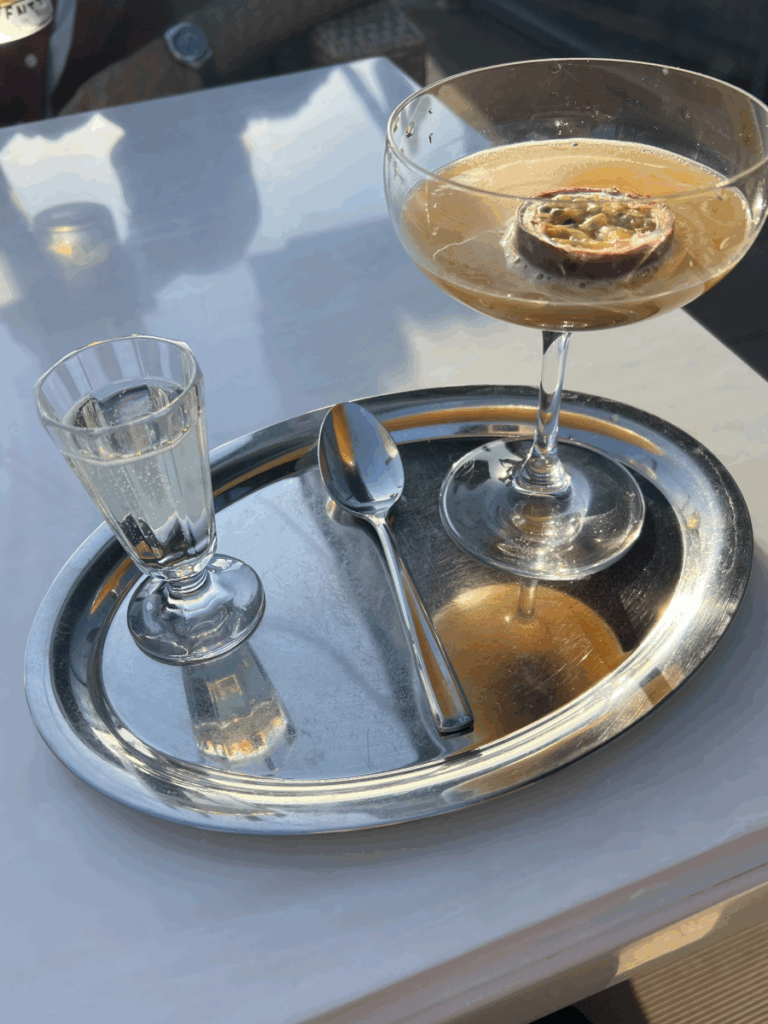
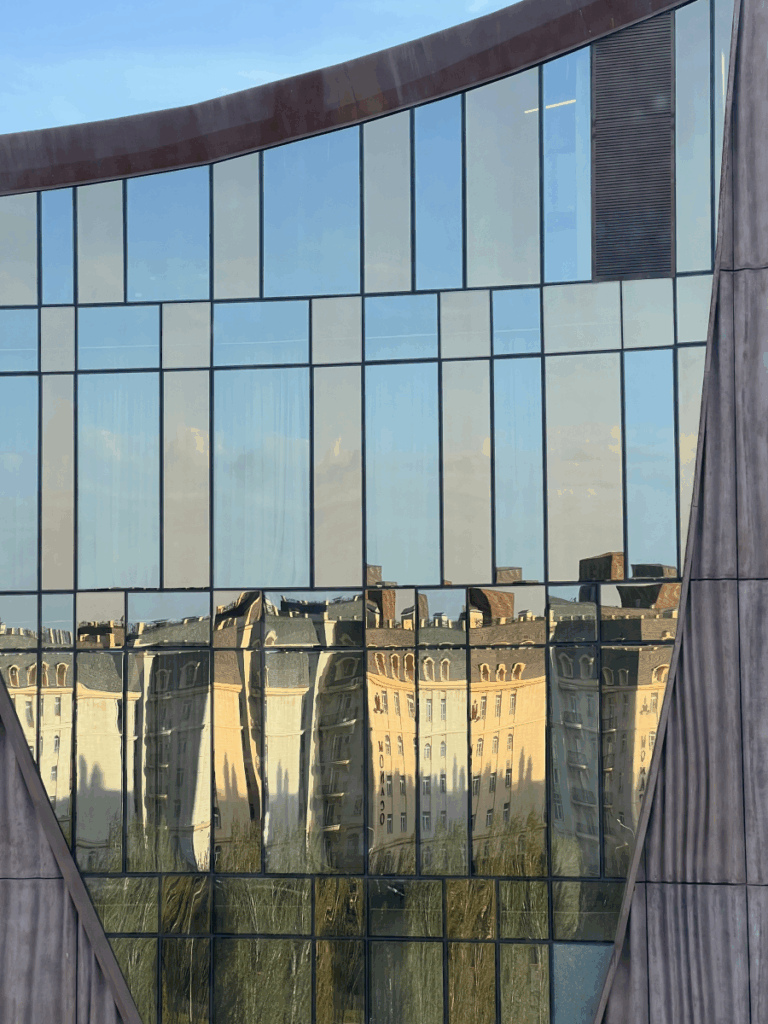
8. Explore the “old town” side of the river
Cross the Ishim River to discover what locals call the “old town”—it’s low-rise, lived-in, and feels entirely different from the futuristic side of the city. There’s the Russian Drama Theater, a few cafés, and the Saken Seifullin Museum (we didn’t go inside, but if you love history, it’s there).
Quick tip: Take your time here. It’s more about the atmosphere than any single landmark.
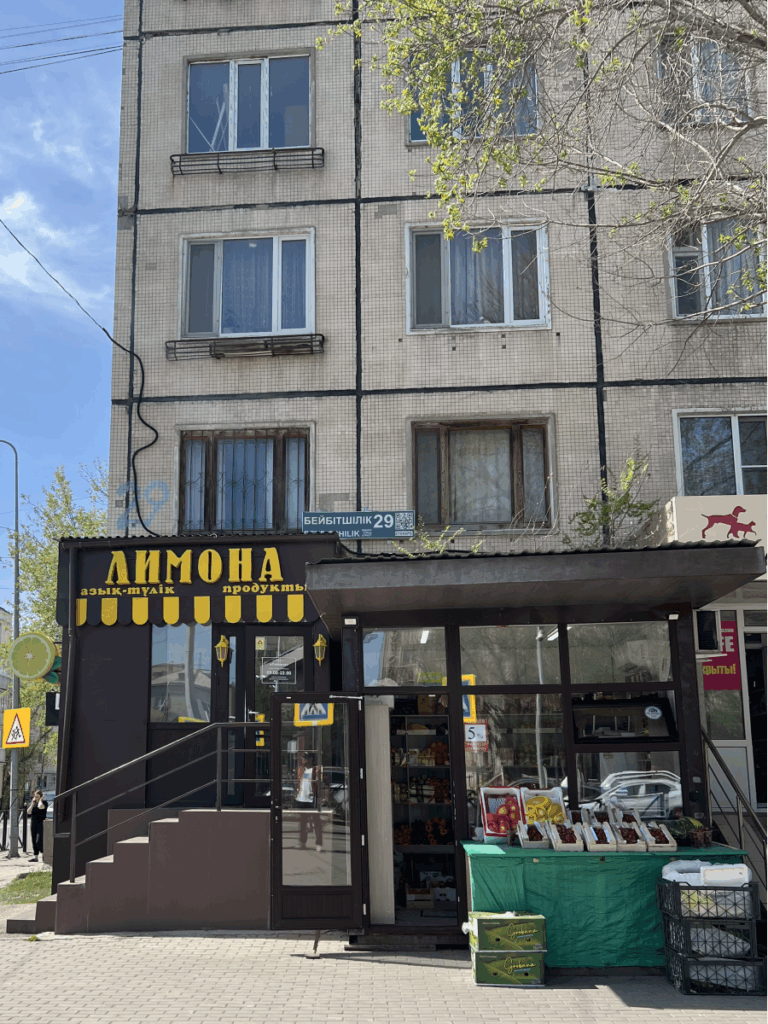
9. Walk the Ishim riverbank
One of the nicest ways to see a different side of Astana is by walking along the Ishim River. We strolled from the old town back toward the palace, crossing modern bridges and passing locals biking, jogging, or just enjoying the outdoors. Along the way, there are big white swinging benches every few minutes—perfect for taking a break and watching the river go by.
Quick tip: It’s an easy walk in any season, and the swings make it a relaxing spot to pause for a while.
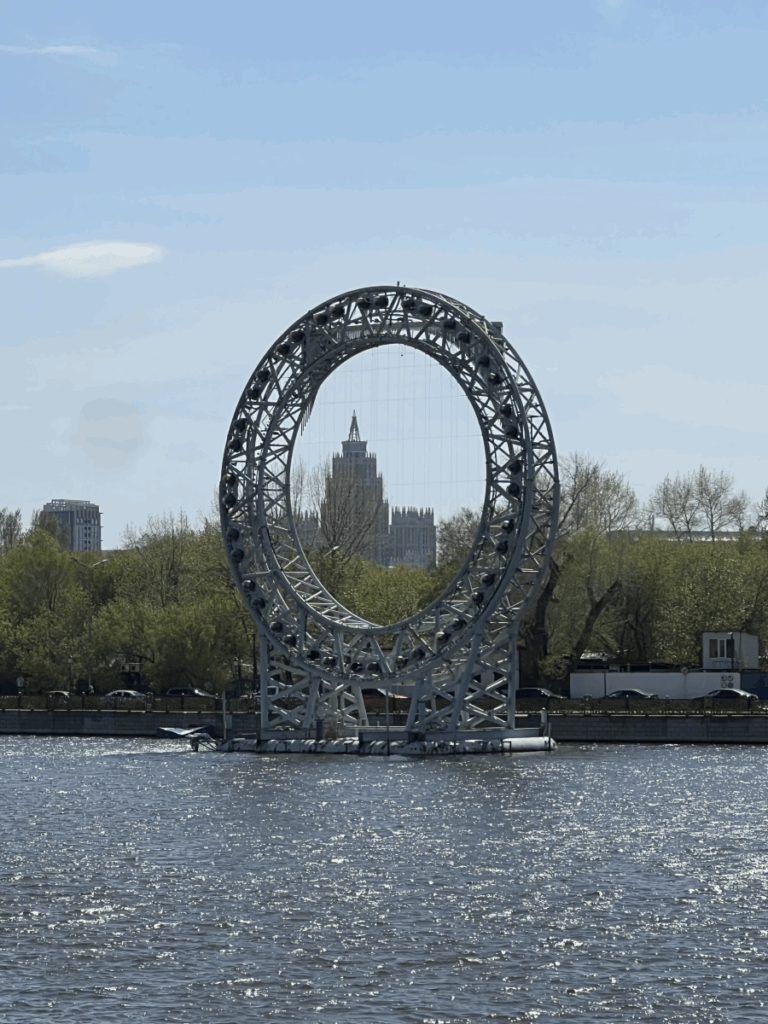
10. More things to do in Astana (if you have time)
We didn’t have time for everything, but these are also commonly recommended if you have an extra day in Astana:
- Palace of Peace and Reconciliation: A striking glass pyramid known for its bold architecture, panoramic views, and cultural exhibitions. Even if you don’t go inside, the building itself is one of the city’s most recognizable landmarks.
- Khan Shatyr Entertainment Center: A futuristic, tent-shaped shopping and entertainment complex that’s as much about the unusual design as what’s inside. You’ll find shops, cafés, and even an indoor amusement park beneath its soaring canopy.
Where to stay in Astana
We stayed in an Airbnb during our time in Astana—perfect if you’re planning to work remotely, stay longer, or simply prefer having more space.
For reference, we paid around $175 USD for 7 nights—a steal compared to most capital cities. Apartments here are modern, spacious, and give you a glimpse of local life beyond the city’s futuristic facades.
If you’d rather check into a hotel, here are curated recommendations for every style and budget.
Luxury (from around $280 USD/night)
- The Ritz-Carlton Astana – from around $250 USD/night
Sleek skyline views, an indulgent spa, and five-star service—this is Astana’s most luxurious address for travelers craving upscale, curated comfort.
- The Veil Hotel – from around $200 USD/night
Boutique luxury at its finest. With intimate, design-forward interiors, The Veil is perfect for travelers who care about style as much as comfort but prefer something less grand than The Ritz.
Boutique & mid range (from around $120 USD/night)
- The One Hotel Astana – from approximately $120 USD/night
A polished four-star hotel with elegant rooms, a full-service spa and an on-site fitness centre. Centrally located near the river, it blends comfort and design with a laid-back, upscale feel—ideal for travelers who want to elevate their stay without going full five-star.
Budget-friendly (from around $50 USD/night)
- Come INN Astana – from approximately $40 USD/night
Modern and thoughtfully designed, Come INN offers boutique style on a budget. With minimalist décor, clean lines, and comfortable rooms, it’s ideal for travelers who want affordability without sacrificing aesthetics.
- Inn OZZ Astana – from approximately $40 USD/night
Clean, comfortable, and friendly, Inn OZZ offers a budget-friendly base with colorful touches and everything you need for a simple stay without breaking the bank.
What to eat in Astana: Local dishes & favorite spots
Kazakh cuisine is hearty, meat-forward, and unapologetically filling. While Astana isn’t exactly known as a foodie capital, there are a few local dishes worth trying, along with some standout spots for coffee, cocktails, and a proper sit-down meal.
Local Kazakh dishes to try
Beshbarmak
Considered the national dish of Kazakhstan, beshbarmak is a plate of hand-rolled noodles topped with boiled meat (often lamb, horse, or beef) served in a light onion broth. It’s rustic, hearty, and very much a “when in Kazakhstan” experience.
I was so excited to try this—I’d seen all the photos, read all the guides. But as soon as I bit into one of the round slices of horse meat… let’s just say it wasn’t for me. Still: worth trying for the story alone.
Kuyrdak
A traditional dish made from organ meats—heart, liver, and lungs—sautéed with onions and potatoes. It’s not for everyone, but it’s a taste of Kazakhstan’s nomadic roots.
Manti
Steamed dumplings stuffed with spiced meat—the Central Asian cousin of Georgian khinkali or Nepalese momos. Comfort food at its simplest.
Baursak
Fried dough balls, somewhere between bread and doughnut, often served as a snack or with tea. I didn’t get around to trying these myself, but they’re known for being light, golden, and dangerously easy to keep eating.
Shubat or Kumis
Fermented camel’s milk or mare’s milk. I skipped this one too, but it’s one of those “when in Kazakhstan” things.
Confession: I didn’t actually try most of the traditional dishes—because I got completely hooked on laghman (technically more Uyghur than Kazakh, but wildly popular here) and horse steak, which I already knew I’d love. Sometimes you just have to follow your cravings.
Where to eat in Astana: Cafés & restaurants I loved
Selfie Restaurant
We had lunch at Selfie, a sleek spot located on the upper floor of the Ritz-Carlton with panoramic views over Astana’s skyline. The menu serves polished versions of Kazakh and international classics, and while it’s slightly pricier than average, it’s still affordable by Western standards. A perfect pick for a relaxed lunch or atmospheric dinner
View Selfie on Instagram.
On The Roof
A chic rooftop bar with a great terrace and sweeping sunset views over Astana’s surreal skyline. The cocktails were good (not exactly groundbreaking), but the prices were definitely on the steep side for the city. Still, for the views and the vibe, it’s worth it at least once.
View On The Roof on Instagram.
Zebra Coffee
For coffee and a casual stop, Zebra Coffee is a popular local chain—an easy option if you need a reliable morning pick-me-up while exploring the city.
(Yes, there’s also Costa Coffee everywhere—but you didn’t come all this way for that.)
We also grabbed breakfast at a place called COFFEE COFFEE, and we loved it. The atmosphere was great, the menu had a huge range of choices, and everything we tried was delicious. It’s exactly the kind of spot you want for a slow morning before work or sightseeing—good coffee, solid food, and an easy vibe. I’m not sure if it’s part of a chain or just a local gem, but it definitely hit the spot.
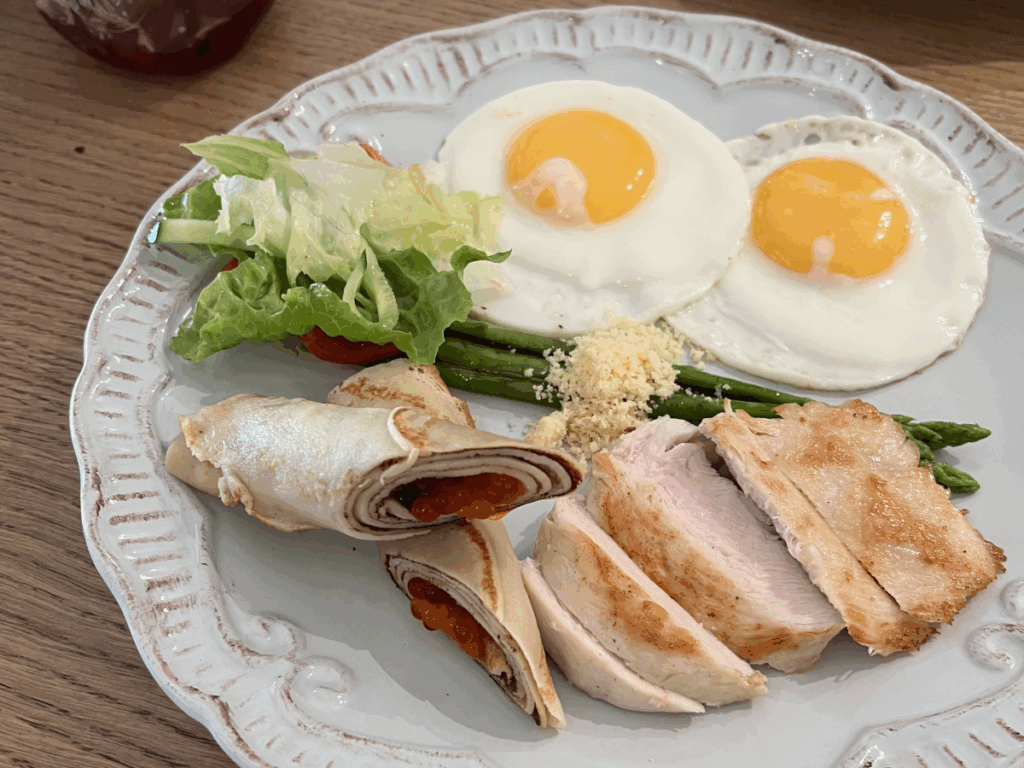
Is Astana worth visiting? My honest take
Astana is… strange. But in the best way.
If you’re the kind of traveler who loves futuristic architecture and off-the-beaten-path capitals, you’ll probably enjoy it here. It’s safe, affordable, and oddly fascinating—a city that feels like a movie set waiting for actors to show up.
If, however, you’re looking for bustling nightlife or charming old towns, Astana might leave you cold—literally and figuratively.
For me, it was worth it. Not because I fell in love with the city, but because it made me think. It left an impression. And sometimes, that’s the best kind of travel.
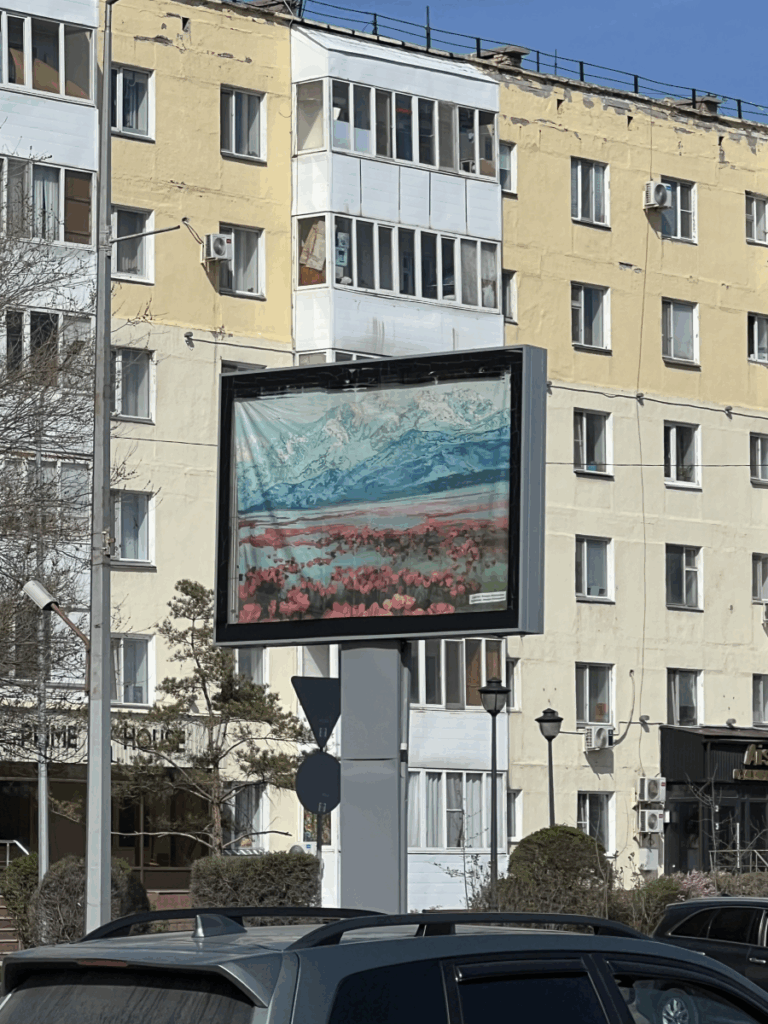
Practical travel tips for visiting Astana, Kazakhstan
A few things to know before visiting Astana—because while the city may feel surreal, the logistics don’t have to.
Do you need a visa to visit Kazakhstan?
Many nationalities, including travelers from the US, Canada, the UK, and most EU countries, can visit Kazakhstan visa-free for up to 30 days.
That said, visa rules can change, so it’s always wise to check the latest Kazakhstan visa requirements before you book.
What language is spoken in Astana?
Both Kazakh and Russian are official languages, but in Astana, you’ll hear Russian far more often in daily life.
English is limited—hotels and higher-end restaurants usually manage fine, but don’t expect fluent conversations. A translation app or learning a few basic Russian phrases can go a long way.
Money & currency: How much does Astana cost?
The currency in Kazakhstan is the Kazakhstani Tenge (KZT).
As a rough guide:
- $1 USD ≈ 519 KZT (check current rates before you go)
- A nice meal: $10–20 USD per person
- Taxis and casual dining: surprisingly cheap
Credit cards are widely accepted, but it’s smart to carry some cash for small shops or markets.
What to wear in Astana: Dress code tips
Astana is a modern, secular city where most styles are acceptable—think European urban casual.
- Summer: Light layers are ideal. Evenings can be cooler than expected.
- Winter: Expect extremely cold weather, with temperatures often dropping below -30°C (-22°F). Proper gear is essential.
- Mosques: Cover shoulders, knees, and for women, hair. Most mosques, including the Grand Mosque, provide robes and scarves at the entrance.
Is Astana safe for travelers?
In a word: yes.
Astana is extremely safe—low crime, calm streets, and a general feeling of order. I never felt unsafe, even after dark. That said, as with anywhere:
- Use official taxis or Yandex Go
- Keep valuables discreet
Final thoughts on Astana
Astana might not be for everyone—but if you’re curious about places that feel different from anywhere else you’ve been, this Astana travel guide hopefully helps you see why it’s worth the trip. It’s safe, affordable, and leaves you with stories you probably wouldn’t get anywhere else.
